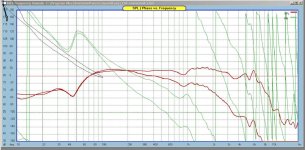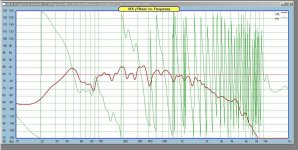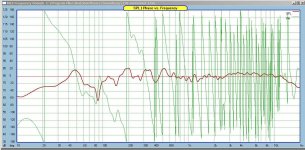Testing report. R5 at 1 Ohm.
For my wife's ultra critical sensitivity to "some" speaker/amp problem, Metal passed. Cloth failed. Not as bad as my other speakers, but failed.
Further details over in the lounge. Exactly the reverse of what I expected. So my conclusion is it is not the breakup modes causing the problem.
I would haven given the advantage to the cloth from my listening. The metal does have some detail advantage, I suspect is it's slight further extension above 18K. Yes, I hear that high.
Testing went well enough I am going to build good cabinets.
For my wife's ultra critical sensitivity to "some" speaker/amp problem, Metal passed. Cloth failed. Not as bad as my other speakers, but failed.
Further details over in the lounge. Exactly the reverse of what I expected. So my conclusion is it is not the breakup modes causing the problem.
I would haven given the advantage to the cloth from my listening. The metal does have some detail advantage, I suspect is it's slight further extension above 18K. Yes, I hear that high.
Testing went well enough I am going to build good cabinets.
Time delay woofer to tweeter of completed system is about 2 ms, which comes out to be about 68mm. More than one can deal with in a sloped box or slight waveguide. It would require a separate box and more separation between drivers.
Yea, looks like I am going to build a rectangular box again. One of the reasons is I have to conform to a low visual impact in the living room. Non-cubic boxes wind up with slightly larger visual size.
Buying one would kind of defeat the whole thing though. Others should note, their half foot box is about perfect when you account for port and drivers. Every pair I do, I do something new. I have some not too common ideas on aesthetics I may try rather than a box covered with oak.
Buying one would kind of defeat the whole thing though. Others should note, their half foot box is about perfect when you account for port and drivers. Every pair I do, I do something new. I have some not too common ideas on aesthetics I may try rather than a box covered with oak.
I think I can see why some of the results from the Madisound kit have been less than optimal. I suspect the drivers have changed a little. For a start, yes the woofer has a bit of a rising response in box, but I measure ( 1M on axis, in box) about half what John mentions in his text: 5 vs 10 dB which tracks very well to the baffle step. In other words, the driver is now pretty flat. The massive inductor was selected to tackle this, but as the current woofers are flatter than when this was designed, the result is a big slump across the midrange causing the perception of grossly overly hot top end. It looks like a 2.5m instead of 3.3 may be closer. It may actually need a traditional BSC network instead. Only testing will tell.
I would suggest making some gated measurements of the speaker at 1meter with ARTA and see what that shows up.
I would also suggest making some measurements of the individual drive units, without the crossovers, to see exactly what's going on.
Your un-gated far-field measurements in post 45 indicate a decently flat in room response.
I would also suggest making some measurements of the individual drive units, without the crossovers, to see exactly what's going on.
Your un-gated far-field measurements in post 45 indicate a decently flat in room response.
Not played with ARTA. I have SoundEasy and TrueRTA. I'll take a look at it. I have used the latter so long I am pretty good at ignoring the room effects, port effects etc. As we all know, truth is something we have to derive from our measurements. Knowing your equipment is critical. No phase measurements though which is where SE is worth the difficulty in using it. My above conclusions were based on 1M, in box, with and without crossover using True RTA quick sweep and SE MLS. When multiple techniques correlate with what you hear, you have something to work from. I need to fix my portable measurement so I can go back to mounting drivers in my garage window and doing IB measurements.
Quite decent, yes. That does not mean I am done. Mind you, just changing R5 to 1 Ohm made these very good. We prefer the metal dome over the cloth, and as it has a bit more extended output, it needs to be backed off a tad for overall balance. I need to build a battery box to power my mic so I can measure in their intended location as it is within that range. ( my main lab is not portable) I should call this X-45 now as the successor to the SR-71. The original design was a case study in simplifying a crossover. Everyone should consider what he did to see how much can be done with how few parts.
And I still have not had time to try out my new 1" radius router bit to compare to the smaller radius with how ragged the diffraction is. I was informed I need a grill cloth, so that adds some baffle complications.
I could get a lot more done if I didn't have to work for a living.
Quite decent, yes. That does not mean I am done. Mind you, just changing R5 to 1 Ohm made these very good. We prefer the metal dome over the cloth, and as it has a bit more extended output, it needs to be backed off a tad for overall balance. I need to build a battery box to power my mic so I can measure in their intended location as it is within that range. ( my main lab is not portable) I should call this X-45 now as the successor to the SR-71. The original design was a case study in simplifying a crossover. Everyone should consider what he did to see how much can be done with how few parts.
And I still have not had time to try out my new 1" radius router bit to compare to the smaller radius with how ragged the diffraction is. I was informed I need a grill cloth, so that adds some baffle complications.
I could get a lot more done if I didn't have to work for a living.
Quick skim of the users manual. Quite interested in the CSD plots which I have never made work in SE. 79 Euro not too bad but I need to read carefully first. I have spent a lot on quite a few programs that did not live up to their expectations.
There are several treads/posts on Madisound forum on SR71.
Here is one on listening fatigue:
ZA SR-71 listening fatigue
Here is one on listening fatigue:
ZA SR-71 listening fatigue
You can do almost everything with ARTA as a freeware product. The only limitation is that you cannot save and reload impulse files, this means you can't make sonograms etc/polar plots, but apart from that you can do everything else.
I suppose I only made my comments about measuring with ARTA and making proper gated measurements because what you said a couple of posts ago seemed to contradict your earlier far-field measurement which showed a very flat response from 500Hz and onwards and it certainly wasn't indicative of any top end rise from the ER18.
I suppose I only made my comments about measuring with ARTA and making proper gated measurements because what you said a couple of posts ago seemed to contradict your earlier far-field measurement which showed a very flat response from 500Hz and onwards and it certainly wasn't indicative of any top end rise from the ER18.
I'll check their site again. I did not see a freeware version. It looks to have less glitz and more measurement. To an old guy like me, that is a good thing. I am not exactly sure about the gating of either of my current tools. I know you can trick the TrueRTA is the level is not high enough. SE MLS I don't know. Logically, there should be a parameter to set for distance if doing a gated test. Right now I am frustrated in trying to figure out how to make a Profire 610 not overdub all the inputs. I know a lot of SE users have it, but I have not had any responses yet. This could be causing erroneous measurements. I am going to try a different approach tonight output through my DCX and input only through the Profire. This is fine for tuning, but the DCX brick walls at 20K and is no help in understanding tweeter breakup.
The ER18 does not seem to have the rise that John talked about and designed to. I think that is why I am seeing a dip in my "as designed" version.
Now, for some barley based liquid food stuffs and back to work.
The ER18 does not seem to have the rise that John talked about and designed to. I think that is why I am seeing a dip in my "as designed" version.
Now, for some barley based liquid food stuffs and back to work.
ARTA is very user friendly, at least I find it to be. There is only 1 version that you can download, if you use it 'as is' then you get the freeware 'demo' version. Then you can buy a release code for the full version should you choose to.
As far as gating measurements go, ARTA's main impulse measurement window gives you a very easy way to set the start and end points for the gate.
Edit - The dips encountered in your measurements occur between 1 and 2kHz, this is smack bang where the crossover frequency is. This area also measures flat with the ER18, the only rise/breakup is encountered far higher up. As the issue occurs roughly where the crossover frequency is, it stands to reason that what you could be measuring is the mid/bass and tweeter being slightly out of phase with one another and creating a dip, this occurs when the mic is placed off the design axis or if the measurement distance is also different to the design distance. Near field measurements almost always show irregularities around the xover frequency for this very reason.
Properly gated measurements on the tweeters axis, taken between 1-2 meters, should help to show exactly what is going on.
As far as gating measurements go, ARTA's main impulse measurement window gives you a very easy way to set the start and end points for the gate.
Edit - The dips encountered in your measurements occur between 1 and 2kHz, this is smack bang where the crossover frequency is. This area also measures flat with the ER18, the only rise/breakup is encountered far higher up. As the issue occurs roughly where the crossover frequency is, it stands to reason that what you could be measuring is the mid/bass and tweeter being slightly out of phase with one another and creating a dip, this occurs when the mic is placed off the design axis or if the measurement distance is also different to the design distance. Near field measurements almost always show irregularities around the xover frequency for this very reason.
Properly gated measurements on the tweeters axis, taken between 1-2 meters, should help to show exactly what is going on.
Last edited:
Got it. It seems to run. Now I have about 300 pages to read to figure out how to use it.
Not sure if I should say thanks or not! I did a quick test, no mic cal, not knowing anything about how it works, and yes, midrange dip. I did have to resort to a users forum on M-Audio to ask about the overdub issue. It seems they rely on users for tech support.
Not sure if I should say thanks or not! I did a quick test, no mic cal, not knowing anything about how it works, and yes, midrange dip. I did have to resort to a users forum on M-Audio to ask about the overdub issue. It seems they rely on users for tech support.
- Status
- Not open for further replies.
- Home
- Loudspeakers
- Multi-Way
- Zaph Audio ZA-SR71 Review!


